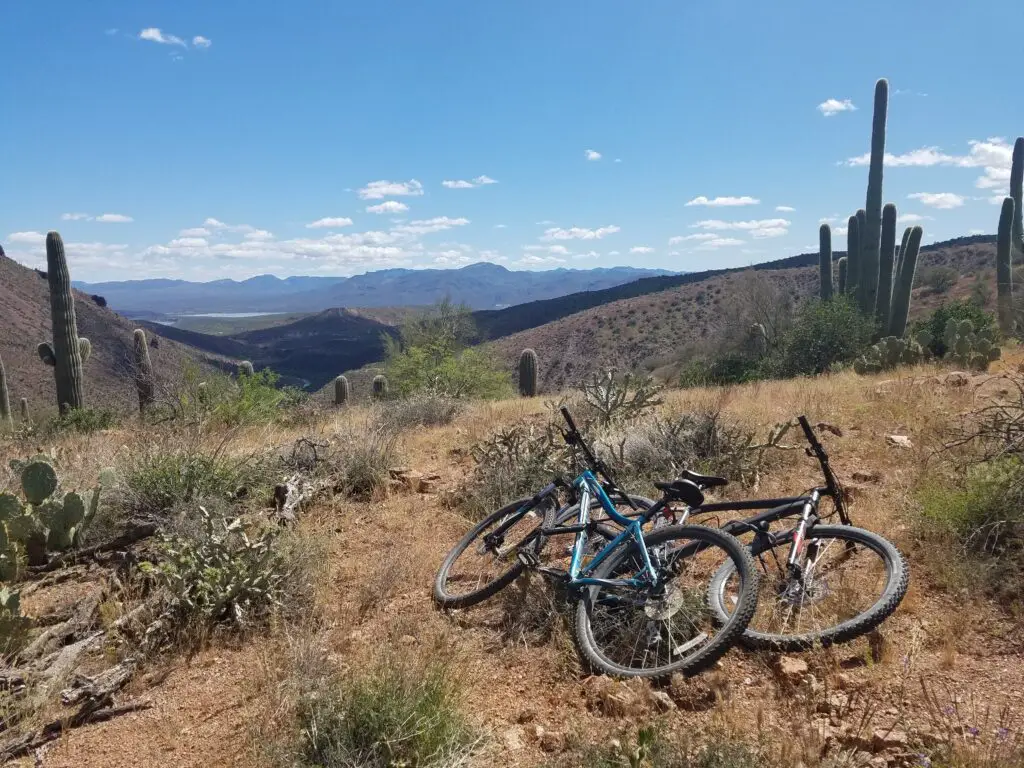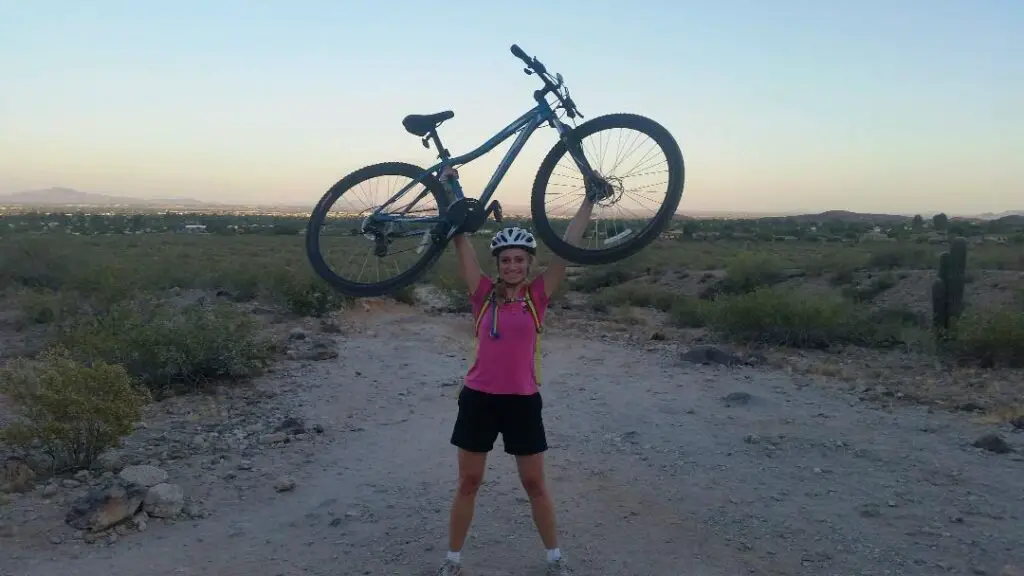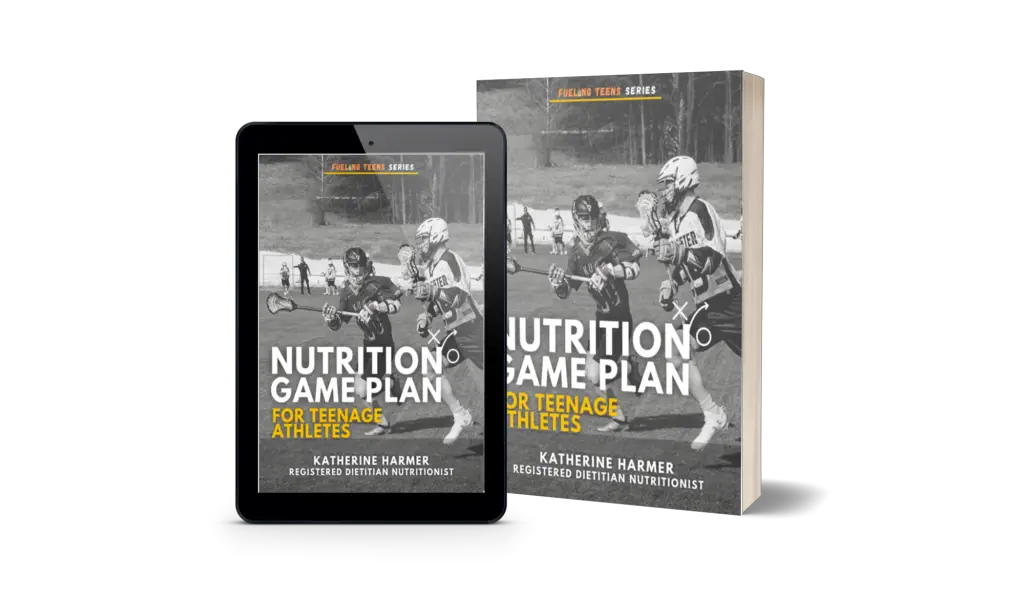I love mountain biking and I’ve been mountain biking for 8 years now. I love the adrenaline, the exercise, the time outside, and working so hard that I earn the downhills. Mountain biking calls for both endurance and power as bikers tackle hills and long distances.
Diligence in proper training, sleep, eating and other lifestyle behaviors supports athletic success in this demanding sport. In particular, dietary choices make a significant impact on a teenage mountain biker’s ability to train, recover and perform. So, what should a teenage mountain biker eat?
A teenage mountain biker should eat nutrient dense foods such as whole grains, legumes (beans, lentils), seafood, eggs, lean meat/poultry, nuts, seeds and healthy fats to meet their higher nutrient needs. Mountain bikers should consume a balance of carbohydrates, protein and fat at eating occasions without restriction of any foods, nutrients or food groups. The exact number of calories and mix of macronutrients depends on the athlete and their unique training and competitive needs. Before a workout or competition, athletes should steer away from foods that cause gut distress and choose easily digested, high carbohydrate and moderate protein meals or snacks.
Discover more about creating an overall healthy eating pattern and hydration plan. Also, proper fueling before, during and after bike rides and races.

What Does a Healthy Meal Pattern Look Like for a Teenage Mountain Biker?
In order to gain a competitive edge, some teenage bikers may feel the need to alter their diet. Certain changes can improve performance but fad diets, limiting food and focusing on a few specific “super foods” do not support good health or athletic ability. Instead, athletes will want to include all food groups and incorporate the principles of balance, variety and moderation.
Balance means including all the food groups in order to benefit from their unique characteristics. Variety comes through trying many different types of foods within each food group to obtain different vitamins, minerals, antioxidants and other nutrients.
Moderation not only means avoiding excess of any one food or nutrient, but also the avoidance of any sort of extreme restriction or food rule. All foods can find a place in a healthy diet when following these principles, including favorite treats.
What Teenage Mountain Bikers Should Eat in a Day:
The following table highlights the different food groups, nutrient dense foods and how they contribute to athletic success and well-being.
| Food group | Amount (1800-3000 calorie estimates) | Nutrient Dense Varieties | Benefits |
| Fruits | 1.5-2.5. cups (c) | Fresh fruit (apples, bananas, berries, pineapple, oranges, guava, grapes, etc.) dried fruit, 100% fruit juice | Full or nutrients such as potassium, vitamin C and folate. A good source of fiber, antioxidants and phytochemicals that help prevent chronic disease. These carbohydrate rich foods offer a perfect pre-bike ride snack. |
| Vegetables | 2.5-4 cups | Leafy greens, fresh vegetables (potatoes, squash, cucumbers, broccoli, cauliflower, peas, beans, asparagus, etc.), 100% vegetable juice | Vegetables contain many of the same benefits as fruit. They provide a good source of many of the micro nutrients. They also combat disease and promote heart, digestive and mental health. |
| Grains | 6-10 ounces (oz) | 100% whole wheat, oatmeal, bulgur, barley, quinoa, brown rice, corn tortillas, popcorn, whole grain breads/cereals/tortillas | Both long bike rides and shorter ones require carbohydrates as fuel. Eating an appropriate amount of grains will support a bikers energy needs as they are a great source of both complex and simple carbohydrates. Whole grains add important fiber to the diet as well as energizing B-vitamins. |
| Protein | 5-7 oz | Seafood, lean meat/poultry, legumes, nuts, seeds, eggs, cottage cheese, milk, cheese, yogurt | Frequent consumption of protein foods throughout the day provides the necessary building blocks for recovery and muscle strength. Protein also helps stabilize blood sugar and increases satiety. |
| Dairy | 3 cups | Unsweetened milk, cheese, unsweetened yogurt | The adolescent years marks a crucial time for bone development. Dairy assists in the strengthening of bones through its high content of calcium and vitamin D. Dairy products also provide a great mix of carbohydrate and protein for pre-and post race snacks. |
| Fats | Varies | Unsaturated fats: plant oils, nuts, seeds, olives, avocado, fatty fish and other seafood | Dietary fat is essential to well-being and performance. Poor intake can result in fatigue, nutrient deficiencies and decreased hormonal health. Dietary fat provides energy, stabilizes blood sugar and increases satiety. Unsaturated fats contribute to heart health and should be chosen more frequently than saturated fats. |
This table shows estimates of an athletes dietary needs in a day. However, it is important to note that all athletes experience unique needs, tolerances, allergies and circumstances. Bikers should find what works best for them and ensure they are meeting their energy needs through adequate calorie intake.
Need specific personalized help from a Registered Dietitian Nutritionist? Check out my Teen Athlete Meal Plan eBook with nutrition tips to get you from off-season to competition day!
See also: Best Meal Plan for Teenage Athletes (FREE Download)
What Should a Teenage Mountain Biker Eat Before a Race or Work Out?
Smart nutrition in the hours leading up to a race can be just as important as a teenage athlete’s daily nutrition. During these hours, a biker focuses on eating enough to energize their biking while avoiding food that causes gut distress or energy crashes. A small meal can be eaten 2 to 4 hours before a race and a snack in the 30 min to 2 hour range. Eating too much or too close to an athletic event can cause digestive issues, bloating and a heavy feeling.
Prior to a race or intense workout, bikers will want to emphasize carbohydrate rich foods with some protein. They should limit foods high in fat, fiber, sugar alcohols (often found in foods labeled sugar-free), sugar and other foods that lead to unpleasant symptoms.
Effective Meal Combinations:
- Rice with chicken
- Spaghetti with lean meat
- Egg burrito
- Oatmeal with fruit and nut butter
- Chicken and cheese quesadilla
- Tofu tacos with soft tortilla
- PB&J sandwich
- Greek yogurt and granola
Snack Options:
- Trail mix with dried fruit
- Low-sugar cereal with milk
- Egg on toast
- Cheese and crackers
- Fruit with nut butter
- Tuna fish wrap
Instead of drinking a large quantity of water right before a race, bikers should maintain hydration with consistent drinking of fluids during the days and hours before the event. Urine color best indicates hydration status and teens should aim for a pale yellow color. Athletes may then benefit from drinking around 16-24 oz fluid in the hour before a workout.
Teenage mountain bikers will want to find what works best for their individual needs and preferences. New foods or eating practices should be attempted during training, not before competitions. This habit prevents unpleasant surprises during the race.
See also: The 25 BEST Pre-Workout Meals and Snacks For a Teenage Athlete and The Worst Foods to Eat Before a Competition
What Should a Teenage Mountain Biker Eat During a Race?
Youth mountain biking competitions generally do not last long enough for athletes to need additional nutrition during a race. However, for races or trainings lasting longer than an hour, individuals may find it useful to drink fluids that contain electrolytes and carbohydrates, like a sports drink. The electrolytes assist with hydration and the carbohydrates offer energy. Small, easily digested carbohydrate snack foods can also help stabilize blood sugar for intense and longer duration races. Examples of these include a granola bar, jelly beans, and dried fruit, or anything that can quickly be eaten and tolerated.
For smaller races, focus more on pre- and post- race nutrition. Generally, water works fine during the race as the body can rely on glycogen stores for energy.
What Should a Teenage Mountain Biker Eat to Recover?
In the hours following a race, teenage mountain bikers can start preparing for future events by prioritizing recovery. Your main goal of post-biking nutrition is refueling, rebuilding muscle, and rehydrating.
Refueling:
A race or workout drain a biker’s glycogen (carbohydrate) stores. Consuming nutrient dense carbohydrates after will allow the body to refill those stores and also supports protein synthesis.
Rebuilding Muscle:
Intake of 15-30 grams of protein after strenuous exercise provides the body with the necessary building blocks of protein for repair and strengthening of muscles.
Studies suggest consuming a ratio of 3:1 or 4:1 carbohydrate to protein snack or meal in the 2 hours after competing for optimal recovery.
Rehydrating:
Water is a great rehydrating drink after a tough day mountain biking. Chocolate milk also provides fluid, carbohydrates, and protein. 100% fruit juice or sports drinks can also be appropriate.
Recovery Snack Examples:
- Peanut butter sandwich
- Tart cherry juice and string cheese
- Yogurt parfait
- Dried fruit and nuts
- Chocolate milk
- Toasted chickpeas
Recovery Meal examples:
- Fish with wild rice and roasted vegetables
- Bean and meat chili with baked potato
- Taco salad
- Veggie and tofu curry with whole grain noodles
Later eating occasions can include all types of foods including those high in fiber and fat. Choosing more nutrient dense foods helps athletes meet nutrient demands and recover well.
Athletes should not try to replace 100% of fluid lost while they are in the act of competing. This amount of fluid intake while active could cause cramps and fluid sloshing in the stomach. Instead, athletes should drink 16-24 oz of fluid for every pound of body weight lost in the hours after the event.
See also: The BEST Post-Workout Snacks for Teenagers – Dietitian Recommended!

Should a Teenage Mountain Biker Participate in Carbohydrate Loading?
Endurance athletes often participate in carbohydrate loading. The traditional use of this practice involves a glycogen depletion phase followed by eating a higher carbohydrate diet (around 70% calories from carbohydrates) in the 5-7 days leading up to a competition.
Some studies show simply following a high carbohydrate diet and decreasing exercise for 1 to 3 days prior to the event may be an effective alternative to the traditional approach.
The goal is to increase muscle and liver glycogen stores to their maximum capacity, which then allows endurance athletes to maintain blood glucose levels and complete at a high-level for a longer duration. Glycogen refers to the body’s glucose storage. When athletes deplete their glycogen stores, they experience low blood sugar or “hit the wall” and feel intense fatigue.
According to the mayo clinic, athletes who perform for longer than 90 minutes may see improvements from carbohydrate loading. Adolescent mountain bikers usually compete in shorter races may not see significant benefits from a carbohydrate loading regime.
However, teenage bikers should still prioritize eating carbohydrates as they train and in the days leading up to a race. Glucose derived from carbohydrate foods will fuel their athletic performance and poor intake of this nutrient will harm their ability to succeed . General guidelines encourage eating 45 to 65% of calories from carbohydrates for the average healthy eating pattern.
Instead of focusing mainly on carb-loading right before a competition or long ride, focus on refueling with appropriate carbohydrates each time after a tough workout, that will help your overall energy stores more and benefit you longterm.
Related Posts
- Nutrition Game Plan for Teenage Athletes (including mountain bikers!)
- What is the Best Lunch for Teen Athletes?
Fueling Teens is a participant in the Amazon Services LLC Associates Program, an affiliate advertising program designed to provide a means for sites to earn advertising fees by advertising and linking to Amazon.com. We also participate in other affiliate programs which compensate us for referring traffic.


